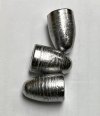ChestnutLouie
Active Member
I did a short casting session using ingots that I buy from a guy who melts them down from WW. I've bought a bunch from him but today one or more of them were wrong. Even at 700 degrees it was very slushy??? I thought that zinc is the most common contaminant and that it melts at about 787 degrees. After lots of skimming and stirring in some sawdust with more skimming it looked sort of OK . My Lee 4-20 pot was about 2/3 full and I began to cast. When the pot got down to 1/3 full alloy was coming out of the spout in a weak stream and bullets started looking like the picture so I stopped casting and dumped the pot. That will be discarded. I re melted the bullets that looked ok added some more ww ingots and an oz of tin and the new melt looked and casted fine.
What do you suppose messed up my first batch? seemed to be slush floating on top.
Thanks
Francis
What do you suppose messed up my first batch? seemed to be slush floating on top.
Thanks
Francis

